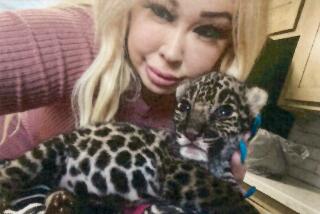Pet Peeves : Not All Households Are Meant to Host the Animal Kingdom
- Share via
This week marks my entry into Decade Three of parenting: our oldest child is turning 20. Entrenched in a college course on human development, her phone calls home have been a blend of inquiries pertaining to her early development and reflections on the skills of her parents. Astonishingly, she grades us highly in some domains of parenting.
Her three siblings--not yet graced with the collegiate wisdom she possesses, nor operating in an environment where we do not have control--still judge us somewhat harshly.
For example, the 9-year-old lamented recently that he wishes he could have had the kind of parents who allowed more pets.
It is true that we have not been as immersed in the raising of pets as we have been in music and sports. Initially, I hesitated to bring a dog or cat into our home knowing that it would be one more responsibility for me. I knew that these same four children who seemed unable to change a toilet paper roll upon its completion would not be the first to change the water, feed the animal or clean up droppings in the yard.
There were weak moments, but I would gain new resolve on rainy days where I could observe my friends, not their children, clad in raincoats with umbrellas in hand, walking dogs early in the morning.
Ultimately, two individuals in the household developed allergies, thus eliminating the possibility of a dog or cat.
We have had a few pets--they just haven’t been the furry, cuddly type.
Whereas we were not completely triumphant with goldfish, we managed well with a lizard and a turtle. Eventually the lizard escaped from it’s warm, climate-controlled habitat. I yet believe it to be the spirited lizard I occasionally observe near the trash cans.
The turtle’s departure from our home happened in full light of day.
The oldest son had left the turtle’s care to me as he left for summer camp. Two weeks later, I noted that it was lifeless. I composed a well-thought out note to our son at camp explaining the demise of Henry the Turtle and explained to our 2-year-old and 5-year-old that we would have a brief ceremony that morning to bury Henry.
There was talk of heaven and hell and I introduced a book dealing with the death of a pet, “The Tenth Good Thing About Barney,” by Judith Viorst. We had a fitting ceremony in the back yard, with appropriate eulogies and music for the turtle.
Just as we were leaving the burial area in the yard, the 5-year-old squealed, “Hi, Henry.” Henry had crawled out of the earth. Well, there were no appropriate books to deal with this phenomenon.
Fortunately, the letter reporting Henry’s miraculous recovery arrived the same day at camp as that note announcing his untimely demise.
As often happens with parents, my resolve is weakening in these twilight years and the fourth child senses it well.
Watching another sibling making plans to head off to college, he pondered aloud, “With him gone, do you think we could have a real pet?”
I realize it would be imprudent to replace a 200-pound fullback/linebacker with a pet that requires comparable care and feeding, but I find myself giving new thought to the domestic animal kingdom.
While leaving the cello to be repaired in Escondido last week, I began checking out some pet possibilities--birds, amphibians and reptiles.
My first stop was A Bird Haven, 2203 E. Valley Parkway, which offers numerous varieties of birds, cages, foods, and educational materials.
Shop owner Sharon Petrarca said that most people do extensive research before purchasing a bird. She does offer advice, though, on the types of birds most appropriate for your type of housing and age of family members. For younger children she suggests baby birds.
“Small children move so fast that they tend to frighten birds not accustom to this activity level,” Petrarca said. “Baby birds adjust better to movement.”
For those who rent their home, Petrarca says that she has found that most landlords are tolerant of birds.
I watched as Lisa Libby fed a small group of baby conures a thickened bird food mixture with a small curved spoon. Like human babies, the baby conures spit out the food when they had had enough to eat.
One larger bird chattered as I toured the store. According to Petrarca, he learned to speak from an older bird on the premise. Now, a bird that could sing as well as Pancho at the Wild Animal Park might be a possibility.
Around the corner from Bird Haven is Reptile Haven, 2201 E. Valley Parkway. One of the first people I encountered there was Kathy Hester, misting the enclosures and handling the reptiles with complete ease.
“Oh, I had four older brothers,” she confided when I questioned how she acquired this remarkable composure with coldblooded creatures.
Chris Estep, brother of Kathy Hester and owner of Reptile Haven, is living his adult life in an environment that any youngster would envy: he’s surrounded by geckos, Burmese pythons, Chilean collards, chameleons, and other reptiles and amphibians.
“Ever since I was little, I’ve had a turtle” said Estep, who grew up in New Jersey and later moved to Escondido, graduating from Orange Glen High School. He points to his rare albino box turtle, Pinky, which he takes home every night.
Estep is experienced in recognizing what might best suit your living situation and child’s interest. Reptiles tend to be low-maintenance pets that require less care than a cat or dog. “However, we don’t let children buy without their parents,” says Estep. Moreover, Estep encourages buyers to read up on the animals before purchasing one.
Estep offers a variety of amphibians and reptiles--such as an albino Burmese python, 8 feet long, which sells for $1,350.
Hester said most people let pythons grow to a certain size and then they put them on a maintenance diet.”
Maintenance diet?
“Yes, maintenance diet. Feeding them less--like one rabbit a month.” This, according to Hester eliminates the aggressive behavior where they are looking for food every few days.
Reptile Haven stocks all varieties of food for the creatures they sell. While in the store, I met Susan Westlund of Valley Center, who was purchasing a live mouse for the California king snake owned by her daughter Becky, 17, a student at Orange Glen High.
Two other browsers, Scott Ashcraft and Michael Scott, both 20, recently moved from New Mexico to San Diego, and have a room in their home called “the reptile room.”
“It’s like a little piece of nature in your own house,” remarked Scott.
Ashcraft spoke of a childhood that encompassed both a dog and reptiles. Scott said he started with snakes as a young man. “My mom wasn’t too happy at first but then she learned to handled them.”
I’m secure that, in time, I, too, could learn to handle a Burmese python, or even a chatty bird. Meanwhile, I’m investigating the habits of geckos.
More to Read
Sign up for Essential California
The most important California stories and recommendations in your inbox every morning.
You may occasionally receive promotional content from the Los Angeles Times.










